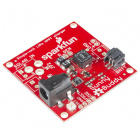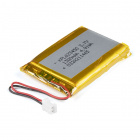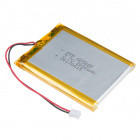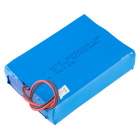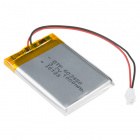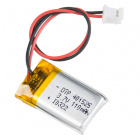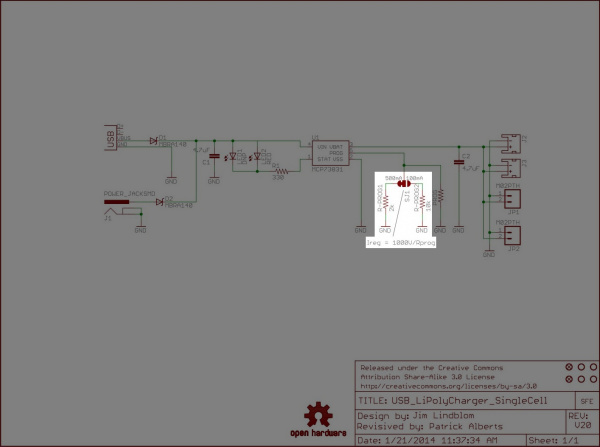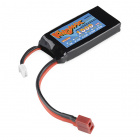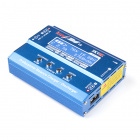Single Cell LiPo Battery Care
Charging LiPo Batteries, Safely
Back in the old days, there were only two chargers available in SparkFun's catalog. The standard charger based on the old MAX1555 IC and our faster charger based on the newer MCP73831 IC. You will notice the MAX1555 and MCP73831 populated as a 5-pin IC as shown in the images below. The MAX1555 was great but its limited charging current (300mA) and diminishing market availability way back when pushed us towards creating chargers based on the MCP73831 (500mA per hour charging rate).
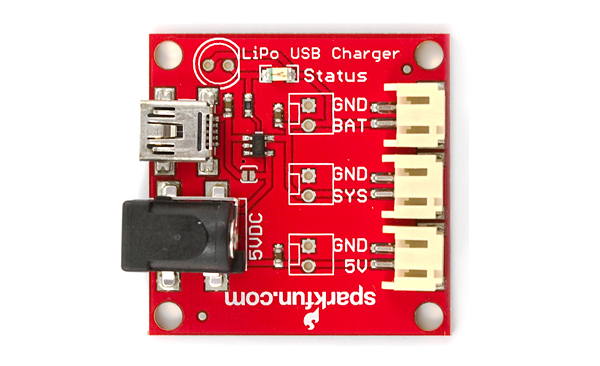 |
 |
| Retired USB Single Cell LiPo Charger with MAX1555 | USB Single Cell LiPo Charger with MCP73831 |
You will notice the MCP73831 populated on select development boards and a variety of breakout boards with different USB connectors. Below are a few examples with the MCP73831 populated on different boards found in the SparkFun catalog.
Other notable LiPo chargers in the SparkFun catalog is the BQ24075 populated on the Battery Babysitter - LiPo Battery Manager, and LT3652 populated on the Sunny Buddy - MPPT Solar Charger. Both can be used to charge a single cell LiPo battery through USB or a solar panel, respectively.
Recommended Charge Rate for Single Cell LiPo Batteries
To avoid explosions (which are only very briefly fun), you should not charge these LiPos at a current over the battery's capacity, typically 1C for fast charging. To be safe [1], you should keep the charge current at or below 1C of your battery as indicated in the datasheets.
What does this mean? Well, lets take a look at the datasheet for the 850mAh LiPo battery. The image shown below highlights the recommended standard charge rate and maximum continuous charge current, where C is the capacity of the LiPo battery. For a standard charge rate of 0.2C, an 850mAh LiPo battery can be charged at a rate of 170mA. When charging at the maximum charge rate of 1C, an 850mAh LiPo battery can be charged at a rate of 850mA.
What does this mean with the LiPo chargers available? Well, if you have an 500mAh single cell LiPo battery, it should not be given a charge current over 500mA. You should use a charger that is able to charge the LiPo battery with a dedicated single cell LiPo charger set at or below 500mA. The minimum LiPo battery that SparkFun has available currently that is compatible at this rate that you can safely charge is 850mAh. Other larger single cell LiPo batteries can also be charged at this rate.
Lithium Ion Battery - 1Ah
PRT-13813What about a 100mAh LiPo battery? Yeah, those should not be charged higher than 100mA. Make sure to find a single cell LiPo charger that is set at or below 100mA. The minimum LiPo battery that SparkFun has available currently that is compatible at this rate that you can safely charge is 110mAh. Other larger single cell LiPo batteries (like the 400mAh shown below or any of the ones shown earlier) can also be charged at this rate.
Depending on the designer, the charge rate can be set to a default rate of either 500mA or 100mA. Certain boards can have a 3-way jumper, switches, and/or PTH footprint to solder a resistor to adjust the charge rate. Below is a schematic of the USB LiPoly Charger. As you can see, this particular board is set at a default rate of 500mA with a 3-way jumper. Cutting the jumper and adding a solder blob between the center pad and the other jumper pad will set the charge rate to 100mA.
But what about that lone 40mAh LiPo Battery in SparkFun's catalog?! If you look closely at the schematic shown earlier, there is also a footprint (not currently highlighted but it is connected to the same net) that allows users to solder a PTH resistor. This allows a user to set the charge rate to a value other than 500mA or 100mA. There's not that a lot of development boards and breakout boards that have the footprint available. Make sure to be careful when connecting a USB cable to those boards when a 40mAh battery is attached. You will want to remove the battery and connect the LiPo battery to a separate LiPo Charger that is set at or below 40mA.
To calculate the resistor needed on a board with the MCP73831, you can use the following formula from its datasheet. Note that this equation is specific for the MCP73831 charge IC.
We'll just skip ahead of the calculations and tell you that the value to charge at a rate of 40mA is... 25kΩ! This is quite an odd number for a resistor value in SparkFun's catalog. You'll need to wire a few resistors wired in series and parallel to connect to the two PTHs (i.e. 10kΩ + 10kΩ + (10kΩ || 10kΩ) ). Or you could use resistor with a larger value like 47kΩ that is included in the resistor kit. However, the charge rate will be less: 21.28mA.





